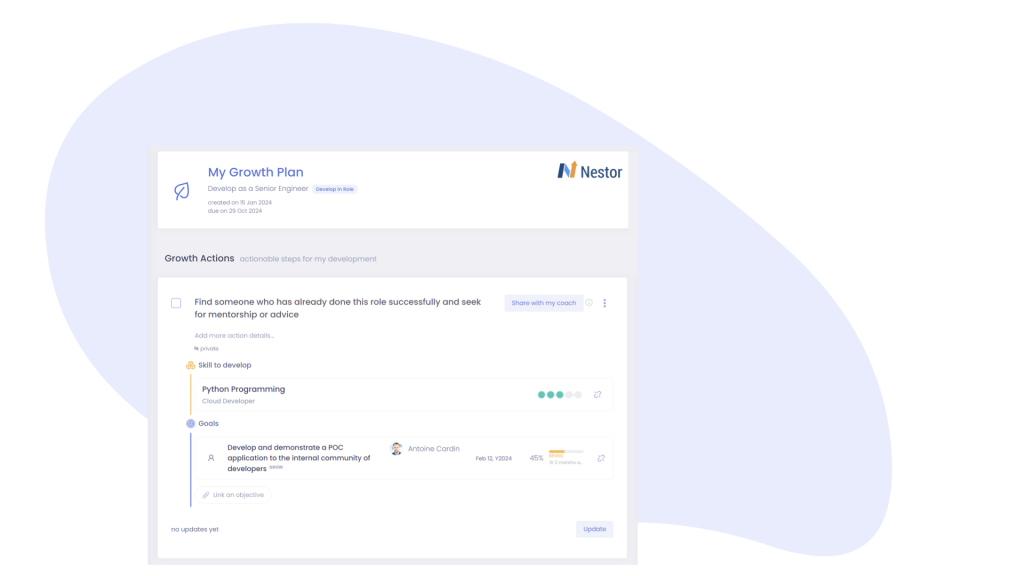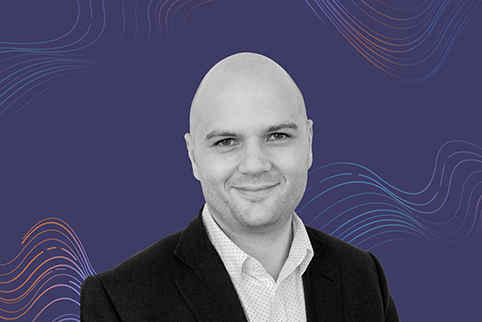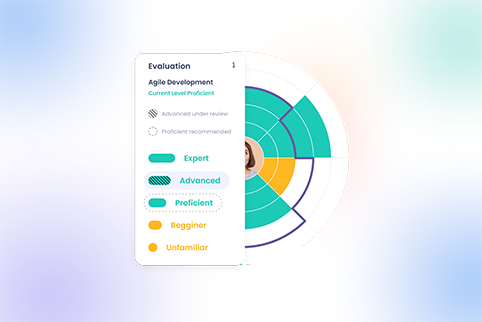
For HR professionals and people managers, the importance of fostering and encouraging growth within teams is not new. But guiding and motivating employees to set powerful career goals is a process, rather than a destination.
And as the modern work environment changes, so do career goals and the best practices associated with them. In this post, we’ll explore the importance and different types of career goals, and the role of the S.M.A.R.T. framework in setting them.
We’re also looking at some actual examples of career goals in 2024 and what you and your employees should keep in mind when writing down goals this year. Let’s dive right in!
What are career goals?
Career goals are clear and well-defined aspirations that people (employees and managers alike) use as a roadmap for their professional journey. The importance of career goals stems from their ability to keep us focused, motivated, and aligned with our desired career trajectory — all while also leaving room for flexibility and transitions to other professions or fields later on.
In addition to improving motivation and focus, well-defined career goals help people make better decisions — such as selecting appropriate learning and development opportunities — and nurture a sense of personal accomplishment and fulfillment over the years.
Setting career goals (and goals in general, for that matter) is effective because that’s how our brains work. Dopamine, or the ‘feel-good’ neurotransmitter is released both when we set goals and as we make progress toward accomplishing them. So, it’s only natural that the motivation and (potential) reward associated with dopamine also make people ambitious and confident when it comes to their professional development.
Different types of career goals
Depending on how you look at them or various factors, career goals can fall into different categories, including:
Short-term career goals
As the name suggests, these include personal aspirations or milestones that can be achieved in the near future (within a few months to a year or a different period of time regarded as ‘short’).
Short-term career goals examples can range from improving a specific skill and acquiring a new certification to obtaining a promotion (e.g., junior to mid-level developer if you’ve already been a junior for some time).
Long-term career goals
Here, people focus on what they can achieve in the next 5-10 years or even longer. These goals are overarching in nature and align more closely with individual values and what someone might call their ‘true vocation’.
Becoming an expert in your industry, occupying a C-level position, or starting your own business are some examples of long-term career goals.
Career growth goals
Also called ‘professional development goals’ or ‘career development goals’, these include all the training, learning, and growth activities that employees use to acquire new skills, expand their knowledge, or overcome some of their current shortcomings.
Some examples of career growth goals are developing leadership skills, finding a mentor, or taking a current ability to the next (proficiency) level.
What’s the relation between career goals and objectives?
Objectives are the measurable short-term actions and targets that people take to make progress toward achieving their larger career goals. We could also call them ‘mini-goals’.
For instance, taking on more responsibility during projects or helping junior team members could be some objectives for someone whose career goal is to end up in a leadership position one day.
On the Nestor platform, here’s what that looks like in a growth plan for Antoine, a made-up employee:

Antoine is currently a Cloud Engineer, but his career goal is to eventually become a Senior Engineer. One of the objectives (or mini-goals) that will help him get there is developing and demonstrating a POC application — something he can achieve by finding a mentor or someone within the organization who has the necessary expertise.
Improving his Python Programming skill is also directly linked with his career goal and he has the opportunity to do that during the development of this POC application.
How to set career goals?
Having looked at the types of career goals that people can have, let’s explore in more detail the process of setting these goals and what it involves, based on insights from the Wall Street Journal:
1. Make career goals your own personal priority
To proactively drive their professional development, individuals should take the initiative in setting their own career goals instead of waiting for directions (or encouragement) from their mangers or mentors (if any).
Of course, it’s great when this support is available from a leader. But even in the absence of it, writing down both short- and long-term career goals shouldn’t be overlooked.
Gen Z and newer generations can struggle more here, since, depending on their educational background, some of them are much more used to receiving prompts or initiatives from authority figures — in the past, teachers and professors, at work, managers or supervisors.
Here are some questions that can help people during this step:
- What career path or paths am I considering for the future?
- How can I break them down into smaller steps or periods?
- What do I need to achieve during each step or period to progress in my desired direction?
- Who do I appreciate in this company? Could I ask them for guidance, mentorship, or some advice?
- What type of career goals are set by colleagues interested in similar career paths?
2. Determine your current professional worth and potential
To effectively leverage your skills and achievements for career advancement, it’s essential to identify your strengths and areas for improvement — this way you’ll also realize what makes you stand out from the rest. Let’s look at a made-up example:
Mark, an employee working in a marketing department, consistently generates innovative campaign ideas that drive significant engagement and conversions, which haven’t gone unnoticed.
Building on this strength, he could set a (short-term) career goal to lead cross-functional teams in the development of three major marketing campaigns over the next year, each aimed at increasing brand awareness and customer acquisition.
By aligning this career goal with the company’s objectives of expanding market reach and driving sales, Mark not only enhances his own career progression but also contributes directly to the company’s growth and success.
This proactive approach demonstrates his value as a strategic asset to the organization, positioning him for potential advancement opportunities and increased recognition within the company.
Here are some questions that can help people during this second step:
- What are my most valuable skills and competencies?
- What are some adjacent abilities that I could easily develop?
- How much can I develop (to what proficiency level) these capabilities in the future?
- What are some areas in which I could benefit from further training and development?
- If I had all the necessary L&D support and materials available, in what direction would I invest my growth and what could I achieve here?
3. Choose long-term career goals that are both realistic and bold
Career goals should be at the limit between comfortable and challenging, but not so challenging that they prevent people from even trying or believing they can achieve those goals — it’s a balancing act, in essence.
By aiming for goals that challenge their current capabilities, employees can tap into their full potential and continuously strive for improvement. This mindset fosters a culture of personal and professional development, where everyone is motivated to stretch themselves beyond their comfort zones and pursue meaningful achievements.
Here are some questions that can help people during this third step:
- If I wasn’t afraid of (potential) failure, what long-term career goals would I set?
- Based on my current skill set and ability to learn, how much do I think I can still grow on my current career path?
- Are current job tasks and requirements challenging enough to stimulate my growth?
- What new tools and solutions could I master to help me do my job even better and faster?
- How can I ensure my goals are aligned with the larger mission of the company and the activity of my team?
The S.M.A.R.T framework
The S.M.A.R.T framework is excellent and often recommended for setting achievable (career) goals:
- Specific: Career goals should be clear and very specific (avoid vague words like ‘better’, ‘more successful’, or ‘after some years’).
- Measurable: Ensure progress and outcomes can be continuously tracked and assessed using well-defined metrics or criteria. This is where breaking down goals into measurable objectives (mini-goals) comes in.
- Achievable: Career goals should be ambitious but still attainable. When setting one, it’s important to consider all factors, from your current skill set and potential to the available resources and the willingness to invest in further development.
- Relevant: To have relevancy, career goals need to align with the broader career trajectory you have in mind and with personal values. Of course, relevancy is also impacted by trends in your industry and the priorities of the employer.
- Time-bound: Career goals (especially short-term goals) should have clear deadlines. Without them, you run the risk of extending certain milestones without a good reason.
Let’s look at a made-up example of Diane, who wants to:
Specific
Transition into a leadership role within my current organization by acquiring the necessary (soft) skills and expertise to effectively manage a team within the next 24 months.
Measurable
I will achieve this goal by enrolling in leadership development courses offered by my company, attending relevant conferences and workshops, and actively seeking mentorship from senior leaders within the organization.
Additionally, I will set measurable milestones, such as completing specific training modules each quarter and taking on additional responsibilities that demonstrate my readiness for a leadership role.
Achievable
Given my current position and the support provided by my company for professional development, I believe that transitioning into a leadership role within the next 24 months is achievable. I will dedicate at least two hours per week to studying leadership principles, networking with other leaders within the company, and seeking feedback on my progress.
Relevant
This goal aligns with my long-term career aspirations to advance within my current organization, take on greater responsibilities, and eventually become a C-level executive. By acquiring leadership skills and transitioning into a managerial role, I will not only contribute to the success of the organization but also enhance my own career trajectory and personal growth.
Time-bound
I aim to transition into a leadership role within my current organization within the next 24 months. To track my progress, I will regularly review my development plan with my manager, set quarterly objectives, and seek feedback from colleagues and mentors to ensure I am on track toward achieving this goal.
What to keep in mind when setting career goals in 2024
So far, we’ve talked about career goals in general and how to set them. But a lot has changed (and is still changing) in the modern work environment. With that in mind, here are some of the things everyone should consider when writing down career goals this year:
Non-linear career paths are increasing in popularity
While vertical moves are still highly desirable, they no longer represent the be-all and end-all of career progress. Lateral and cross-departmental transitions are becoming more common than ever thanks to their ability to:
- bring back a renewed sense of engagement
- help explore or apply skills that are currently underused
- or simply allow employees to stay with the company they love but in a different role
This, combined with the reality that we will live longer and witness radical changes and shifts in the world of work means that embracing flexibility and considering a wider range of career trajectories will soon become a necessity.
Learn more about non-linear career paths.
Emerging skills and sustainable initiatives are changing the game
We know that the half-life of skills is now estimated to be around five years. This is something any employee or manager needs to keep in mind when setting career goals and prioritizing the abilities they want to develop further.
The reality is, that not only are some skills gradually becoming obsolete but others are becoming fundamental and business-critical — and both employers and employees are struggling to acquire them, something highlighted by the ever-growing skill shortages.
Green skills, which are needed for the transition to sustainable practices and (economic) development are an excellent example here.
Generative AI and related skills are here to stay
It all started with OpenAI’s ChatGPT, but now we have Microsoft’s Copilot — which is being integrated into many of their products and services — Google’s Gemini, and many other tools that promise to take over simple tasks and simplify life for modern professionals.
But that’s only true if you know how to use them. While truly understanding how these advanced models work isn’t necessary for everyone, knowing at least the basics and how to write clear and effective prompts to get the results you need is essential.
When setting career goals in 2024, there are few job roles or industries that can afford to not include developing AI prompting skills or any AI-related ability at all.
Skills-based approaches are already making an impact
Many organizations have already begun or at least considered making the switch to skills-based approaches, something that will completely change how the business itself operates and what the talent journey looks like. But what does this mean for workers?
As job definitions and descriptions are becoming skills-based, the same thing happens with L&D initiatives, professional development, and career pathing. That’s because when implemented successfully, skills-based approaches will impact every aspect of talent management.
For people thinking about career goals in 2024, it’s important — regardless of whether their company is skills-first or not — to break down their expertise and capabilities into specific skills and see how these align with their short- and long-term professional aspirations.
When you start to think about your current skills and proficiency levels it also becomes easier to understand what you’re missing — keep an eye on emerging skills in your industry — and where you need to improve further to move toward your career goals.
Career goals examples
Let’s actually look at some career goals examples and why they are important in the current work landscape:
Career goals for 2024
- Plan the next move upward: Whether it is a promotion to a mid-level/senior role or a leadership or supervisor position, achieving higher levels of success and professional satisfaction often comes by taking on additional responsibility and helping other people within the organization.
- Pursue a different career/Make a career change: Making career changes is no longer reserved only for people in their 20s. Professionals across all ages are reconsidering their professional ambitions and long-term career trajectories. IT, for example, is one of the most popular fields toward which people choose to transition.
- Find a mentor: Whether you want to become a knowledgeable senior professional, take on a managerial role, or become an industry expert or consultant — you cannot go wrong by seeking a mentor within the company who’s willing to share their secrets and provide you with personalized guidance and advice.
- Learn to write effective prompts for ChatGPT/Gemini/Copilot: When instructed well, ChatGPT can do many things. From summarizing large texts to coming up with a structure for different types of texts to coding — all is possible when the right prompt is used, and that’s something modern workers need to learn how to do.
- Develop emotional intelligence and emphatic listening: Soft or human skills will take over as the primary skills as AI, digitalization, and automation change the face of the work landscape. And while IQ is something most have heard of, EQ is less popular (or, at least, used to be), and learning how to actively listen and understand where people are coming from is essential, especially in hybrid and remote work environments.
Career goals for software engineers
- Deepen knowledge in a specific in-demand technical area: Some of the areas worth considering include cloud computing (e.g., AWS, Azure), blockchain technology, and cybersecurity, among others.
- Improve software design and architecture skills: It’s more important than ever to understand and find better ways to design scalable, maintainable, and secure software systems.
- Enhance communication and collaboration skills: This is in line with the increasing importance of soft skills we’ve touched upon earlier. Even if software engineering isn’t a communication-centered job, sharing personal ideas and understanding those of others is essential when working with engineers, stakeholders, and clients.
- Contribute to open-source projects: Not only is it a great way to gain experience, showcase your skills, and expand your network, but it’s also an opportunity to give back to the developer community and contribute to the open-source world that has given us amazing projects — with Linux perhaps the best example.
Career goals in marketing
- Become proficient in marketing automation: The levels of sophistication and the usefulness of marketing automation tools will keep on increasing. And this is why having the ability to make the most out of them is becoming a highly valuable skill.
- Develop strong data analysis skills: Nowadays, it’s becoming virtually impossible to measure the effectiveness of campaigns without the ability to collect, analyze, and — most importantly — interpret marketing data from different sources.
- Learn how to create content for and with new platforms: As newer platforms emerge, marketers need to adapt their content creation strategies to these new formats (e.g., TikTok). Similarly, Canva now stands out as a simple yet effective tool for creating quick and impactful designs that don’t always require the input of a graphic designer, helping marketers do more with less. And keep an eye on SORA, the new text-to-video generative AI model from OpenAI that promises to revolutionize video content creation.
- Build a strong personal brand: In the increasingly connected digital world, having a reputable online presence, a wide professional network, and an active engagement with others is essential for promoting not only products and services but also ideas.
Frequently Asked Questions (FAQs) about career goals
What is a career goal?
A career goal is a specific and clearly defined aspiration that people use to guide and stay on their chosen path for professional development.
Why are career goals important?
Career goals are important because they provide direction, motivation, and a sense of purpose and personal fulfillment in one’s professional journey. Without them, it would become very difficult to make informed decisions or accurately measure the progress made toward a specific goal.
How can short-term goals best lead toward accomplishing long-term career goals?
Short-term career goals serve as stepping stones toward accomplishing long-term career goals by breaking down people’s larger aspirations into more manageable, measurable, and achievable (short-term) milestones.
What are some examples of career development goals?
Popular examples of career development goals include enhancing communication and presentation skills (public speaking), seeking mentorship or coaching to take on a leadership or business-critical position, acquiring new skills to improve performance in the current role, etc.







